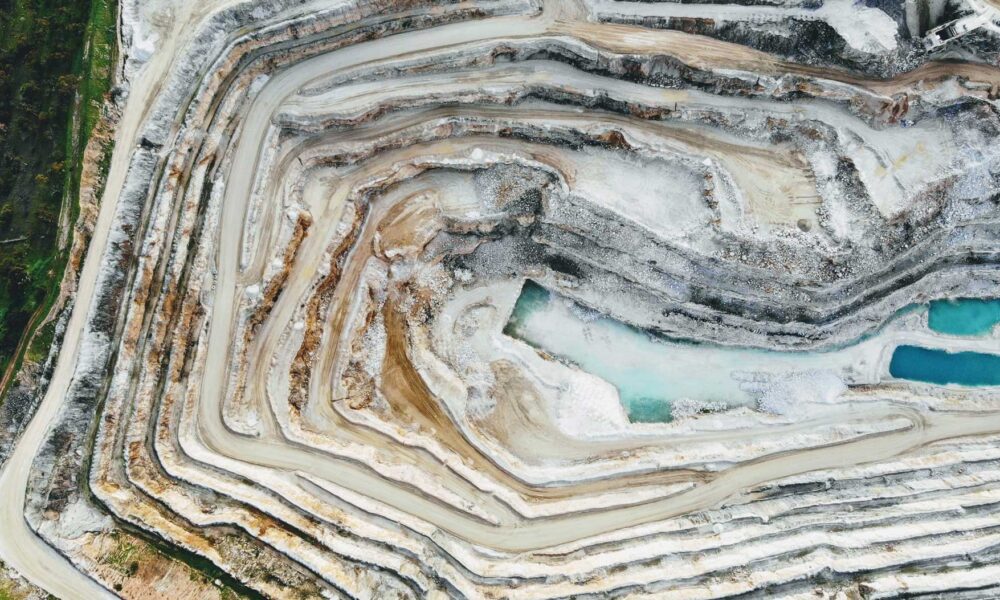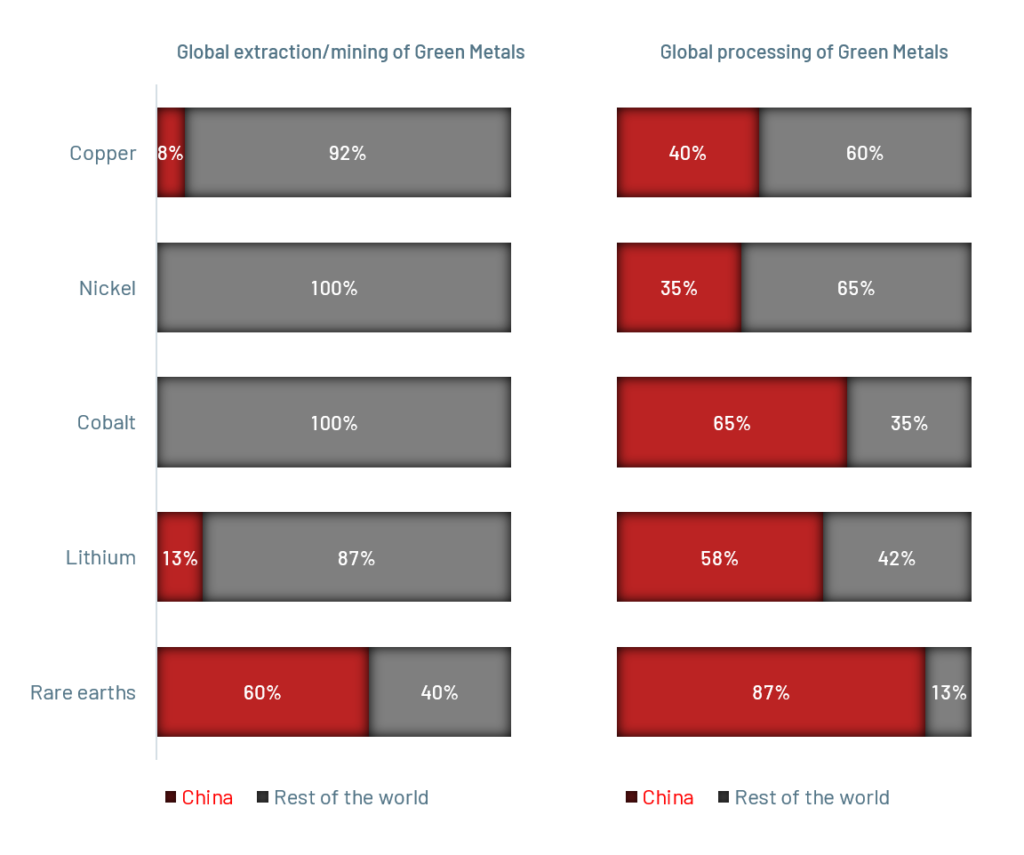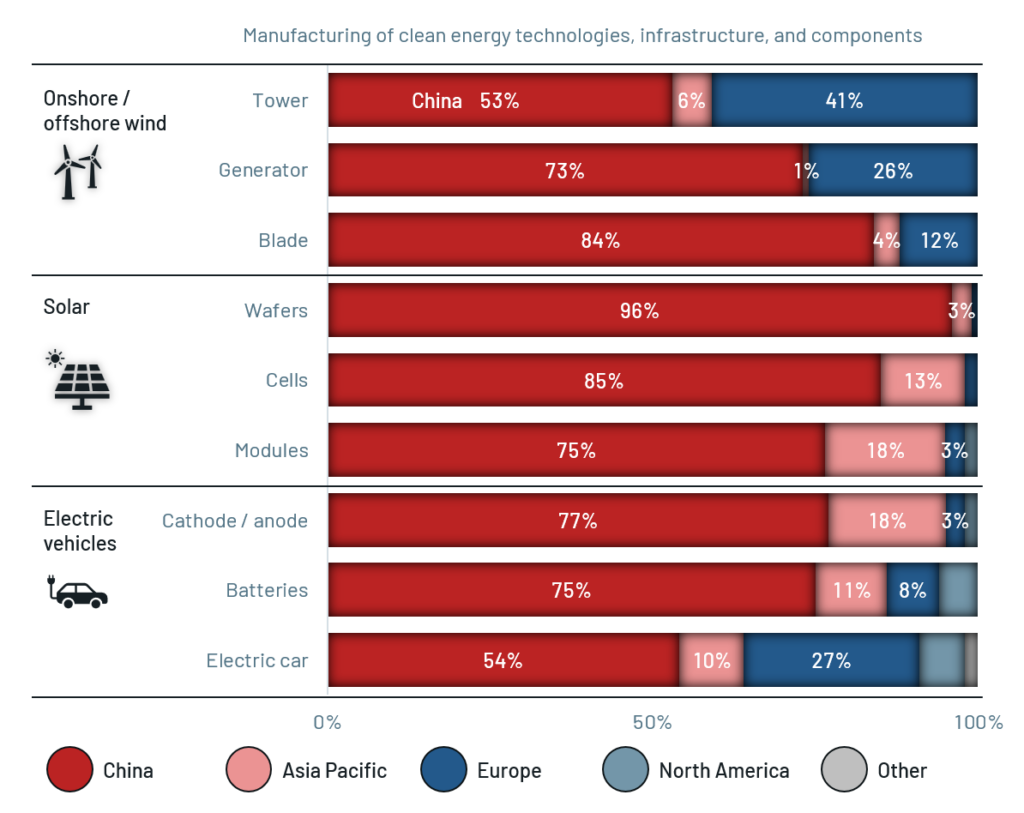Chinese Control of Green Energy Metals
As countries all around the world pursue the transition from fossil fuels to renewables, green energy metals are becoming increasingly important. World leaders are jostling for control over the production and processing of lithium, copper, cobalt, nickel and others, rewriting geopolitical lines and adding new impetus to ongoing (and potentially new) conflicts.
China has emerged as the dominant force, which is adding to existing tensions with the West. But the competition for influence over supply dynamics also offers an opportunity for investors to profit from the growing trade and blossoming demand for green energy metals (including rare earth elements). While some may categorize it as a battery ETF, a raw commodities product like CHRG ETF makes it possible to benefit from global trends no matter who dominates supply.
Green Energy metals are growing in importance
The green energy transition – with power generation from solar, wind, and other renewables -, is expected to expand 300% from 2020 levels by 20351. This requires green energy metals, particularly copper for the miles of wires and cables, and lithium, cobalt, and nickel for the batteries that store green energy and power electric vehicles (EVs). Global demand is predicted to outpace supply within the next decade2.
As the world’s largest processor of these green metals, and the world’s largest manufacturer of green energy technologies, China desperately needs to secure its own supply chain to maintain its global position. It’s estimated to have just 16% of the mined copper it requires, leaving it short around 7.5 million tonnes (Mt) a year and pushing for increased production3.
Analysts at Wood Mackenzie calculate that even the base case scenario will see the world’s nickel production rise by almost 80% in the next 20 years, cobalt demand by 180%, and lithium by 510%, and that’s the lower estimate4. If this race to decarbonization continues to accelerate, demand for green energy technologies will outpace supply, which in theory should lead to price appreciation across the supply chain, including the raw materials.
This makes direct commodity exposure through a nickel, cobalt, or copper ETF highly appealing for investors looking for opportunities. But nation states that have net zero targets are just as eager to profit from green energy metals, and even more importantly, to take control over their supply chains of these in-demand minerals. And China is leading the run.
China dominates the green energy metal trade
While green energy metals are abundant in the planet as a whole, there are very few areas where they can be found in mineable quantities. Copper is mined largely in Chile and Peru; the highest concentrations of nickel are in Indonesia, Australia, and the US; lithium in Chile, Argentina, Australia, and China; and over 60% of cobalt is mined the Democratic Republic of Congo5.
But as shown on the graph below, while mining activities are somewhat scattered around the world, the minerals are mostly processed in China.6
China manages the vast majority of the production of components needed for renewables. 85% of the world’s lithium-ion battery production, 50% of EVs, and close to 70% of solar panels are made in China, and it’s the biggest manufacturer of wind turbines7.
In contrast, the US is currently lagging far behind. It has very few domestically-produced key components8, and EV battery manufacturing capacity is approximately 50% and 63% of that needed by its home EV market in 2023 and 20249, yet it is one of the largest consumers of the finished products!.
China’s dominance is no accident. It was late to the fossil fuel game, which left it dependent on others for most of its energy up till now. It’s determined not to repeat the mistake with clean energy. The CCP’s plan for energy independence requires control over both the production of clean energy systems, and the green energy metals supply chain.10
According to Wood Mackenzie’s Gavin Thompson, Huang Miaoru, and Zhou Yanting, China’s blueprint for net zero is “the most important energy-market document in history. It will shift the global balance of power.”11
Other countries are jostling for a share
In fact, it already is. The US and Europe see the power that OPEC has regarding oil, and OPEC controls approximately 60% of the trade. China’s share of green energy metals trade is already higher, provoking governments around the world to find ways to restrict it.12
In the US, the recent Inflation Reduction Act (IRA) set aggressive targets and incentives to reshore mineral processing and production for components such as photovoltaic cells and EV batteries, and ally-shore a rare earths supply chain. The US is not alone; Wood Mackenzie chairman and chief analyst Simon Flowers observes that “every country pursuing Net Zero wants to do what the US is doing – establish its own domestic low carbon supply chain to reduce dependence on China”13.
But the reality is that very few green energy metal supply chains exclude China, and many companies and countries will be competing for them. The stakes are high for green energy metal supply dynamics.
This is worrying for world leaders who are trying to check China’s dominance, but it offers a big incentive for a number of other states. Countries with significant mineable deposits could expand their share of the global trade, and others to develop the capabilities to process critical minerals mined elsewhere.
Australia is an appealing alternative for lithium, nickel, and graphite, as are many Latin American countries. Companies in areas with lower mineable resources, including Indonesia, the Philippines, Brazil, Mozambique, and Madagascar, offer mineral processing capabilities which could be ramped up.14
Much depends on the level of investment and support that Western countries offer, to help accelerate green energy metals production and processing. It’s likely that a great deal more resources will soon pour into this vertical, which in turn opens up opportunities for investors.
Investors could profit from global green energy metal competition
Investors can profit from the global race to control green energy metals, no matter which country comes out on top. With so much demand for critical minerals, metal exposure could be a valuable addition to investor portfolios. The challenge, as always, is identifying which metal stock will benefit the most.
This is why a lithium ETF, copper ETF, nickel ETF or cobalt ETF, or an electric vehicle ETF which includes EV battery stocks, can be an appealing alternative. CHRG is an ETF that tracks the raw materials needed for EV batteries, including copper, lithium, cobalt, and nickel. An ETF like CHRG enables investors to spread their investment across a number of promising commodities stocks, helping mitigate their exposure to risk and balance their portfolios.
- “100% Clean Electricity by 2035 Study,” NRELTransforming Energy, https://www.nrel.gov/analysis/100-percent-clean-electricity-by-2035-study.html#:~:text=As%20modeled%2C%20wind%20and%20solar,terawatts%20of%20wind%20and%20solar.
- “Are green energy commodities the new “safe haven” for investors?” EMG Advisors, July 6, 2023. https://www.emgadvisors.com/are-green-energy-commodities-the-new-safe-haven-for-investors/
- “Tectonic shift: China’s world-changing push for energy independence” Wood Mackenzie, March 2021
- “Tectonic shift: China’s world-changing push for energy independence” Wood Mackenzie, March 2021
- “The 3 Geo’s of Green Metals The Geographical, Geological, and Geopolitical considerations impacting the Global Energy Expansion ” CHRG presentation
- “The 3 Geo’s of Green Metals The Geographical, Geological, and Geopolitical considerations impacting the Global Energy Expansion ” CHRG presentation
- “Tectonic shift: China’s world-changing push for energy independence” Wood Mackenzie, March
- “The Edge: Cutting dependence on China’s renewables supply chain” Wood Mackenzie June 1, 2023
- “Inflation Reduction Act: Where could automakers shift their supply chains?” Wood Mackenzie, May 2023
- “Tectonic shift: China’s world-changing push for energy independence” Wood Mackenzie, March 2021
- “Tectonic shift: China’s world-changing push for energy independence” Wood Mackenzie, March
- “The 3 Geo’s of Green Metals The Geographical, Geological, and Geopolitical considerations impacting the Global Energy Expansion ” CHRG presentation
- “The Edge: Cutting dependence on China’s renewables supply chain” Wood Mackenzie June 1, 2023
- “Inflation Reduction Act: Where could automakers shift their supply chains?” Wood Mackenzie, May 2023
Investing in ETF’s involves risk, including possible loss of principal. International investing may be subject to special risks, including currency exchange rate volatility, political, social or economic instability, less publicly available information, less stringent investor protections, and differences in taxation, auditing and other financial practices. Investment in emerging market securities involves greater risk than that associated with investment in foreign securities of developed foreign countries. The Fund invests in securities of companies of all sizes, including those that have relatively small market capitalizations. Investments in securities of these companies involve greater risks than do investments in larger, more established companies. Derivatives include instruments and contracts that are based on, and are valued in relation to, one or more underlying securities, financial benchmarks or indices, such as futures, options, swap agreements and forward contracts. The Adviser may engage in speculative transactions which involve substantial risk and leverage, such as making short sales. The use of leverage by the Adviser may increase the volatility of the Fund. Because the Fund invests in financial instruments that are linked to different types of commodities from the metals sector, the Fund is subject to the risks inherent in the metals sector. Such risks may include, but are not limited to: general economic conditions or cyclical market patterns that could negatively affect supply and demand in a particular industry; changes in environmental conditions, energy conservation and environmental policies; competition for or depletion of resources; adverse labor relations; political or world events; increased regulatory burdens; changes in exchange rates; imposition of import controls; obsolescence of technologies; and increased competition or new product introductions. The exploration and development of mineral deposits involve significant financial risks over a significant period of time, which even a combination of careful evaluation, experience and knowledge may not eliminate. Few properties which are explored are ultimately developed into producing mines. The Fund invests in companies that are economically tied to the lithium industry, which may be susceptible to fluctuations in the underlying commodities market. Commodity prices may be influenced or characterized by unpredictable factors, including, where applicable, high volatility, changes in supply and demand relationships, weather, agriculture, trade, changes in interest rates and monetary and other governmental policies, action and inaction. Securities of companies held by the Fund that are dependent on a single commodity, or are concentrated on a single commodity sector, may typically exhibit even higher volatility attributable to commodity prices.
Shares are bought and sold at market price (not NAV) and are not individually redeemed from the Fund. The returns shown do not represent the returns you would receive if you traded shares at other times. Brokerage commissions will reduce returns. The market price returns are based on the official closing price of an ETF share or, if the official closing price isn’t available, the midpoint between the national best bid and national best offer (“NBBO”) as of the time the ETF calculates current NAV per share. NAVs are calculated using prices as of 4:00 PM Eastern Time.
The Energy & Minerals Group EV, Solar & Battery Materials (Lithium, Nickel, Copper, Cobalt) Futures Strategy ETF is distributed by Quasar Distributors, LLC.
Investors should carefully consider the investment objectives, risks, charges and expenses of the The Energy & Minerals Group EV, Solar & Battery Materials (Lithium, Nickel, Copper, Cobalt) Futures Strategy ETF. This and other important information about the Fund is contained in the Prospectus, which can be obtained by calling 1-800-617-0004 or visiting www.emgadvisors.com. The Prospectus should be read carefully before investing.




